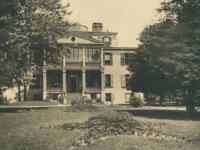This Halloween the Historical Society of Pennsylvania brings you the story of a haunted mansion and its supernatural occupants. This tale begins in the early 1800s in a mansion in Montgomery County in the town of Cynwyd.
The mansion, called the Highlands, was built in 1833. It contained 33 rooms, a wine cellar, and a secret passageway purportedly used as part of the Underground Railroad. According to legend, an officer in the Union Army lived in the mansion with his wife quite happily. Upon returning home from the Civil War, he found his beloved spouse in the arms of a handsome doctor. Enraged, the officer drew his pistol, shot the man, and buried him in the basement. Shortly afterward the officer committed suicide by shooting himself. Pneumonia later took the life of his estranged wife.
In 1888, lawyer William McGeorge Jr. and his family moved to the mansion. For many years  after the reported deaths, residents of the “McGeorge Mansion” would occasionally see a man in a military uniform and a lady in grey who they presumed to be his wife. Every member of the McGeorge family who resided at the mansion claimed the specters existed. They named the ghosts the “Colonel” and the “Little Grey Lady.” They said the Colonel never “met anyone face to face” and “was always seen walking away. Sometimes he would be in the driveway, or sometimes at the window of the blue room, overlooking the lawn.” His wife “always appeared at twilight or about midnight” and was often heard playing the piano.
after the reported deaths, residents of the “McGeorge Mansion” would occasionally see a man in a military uniform and a lady in grey who they presumed to be his wife. Every member of the McGeorge family who resided at the mansion claimed the specters existed. They named the ghosts the “Colonel” and the “Little Grey Lady.” They said the Colonel never “met anyone face to face” and “was always seen walking away. Sometimes he would be in the driveway, or sometimes at the window of the blue room, overlooking the lawn.” His wife “always appeared at twilight or about midnight” and was often heard playing the piano.
During reconstruction in the late 19th century, human bones were found in a sealed room at the mansion, according to a published account. A newspaper article in June of 1935 also attested that “an ancient brick vault was uncovered….deep underground” below the mansion itself, strengthening the belief that the structure “was used before the Civil War as a hiding place for runaway slaves,” though others believed it to be simply the remains of the old wine cellar. Many of the historic artifacts contained within the mansion, including its mahogany doors and an old staircase, were once part of the home of Robert Morris, the famous financier of the American Revolution.
Although a large part of the house was torn down in 1933, the McGeorge Mansion and its former supernatural occupants have continued to generate folklore. Newspaper accounts in the Philadelphia Evening Bulletin and Philadelphia Record contain details about its haunting. Albert Joseph Edmunds, a native-born Englishman and long-time cataloger here at the Historical Society of Pennsylvania, was an avid spiritualist and ghost-hunter. He is said to have notified London’s Society for Psychical Research about the haunting at the McGeorge Mansion.
Apartments and law offices have since occupied the site of the former mansion; however, the stories of its ghostly happenings continue to survive in local folklore. This and similar material, including photographs, newspaper clippings, and publications relative to other haunted sites located within the Delaware Valley, abound within the collections of the Historical Society of Pennsylvania. They await modern-day ghost hunters, if you dare!


